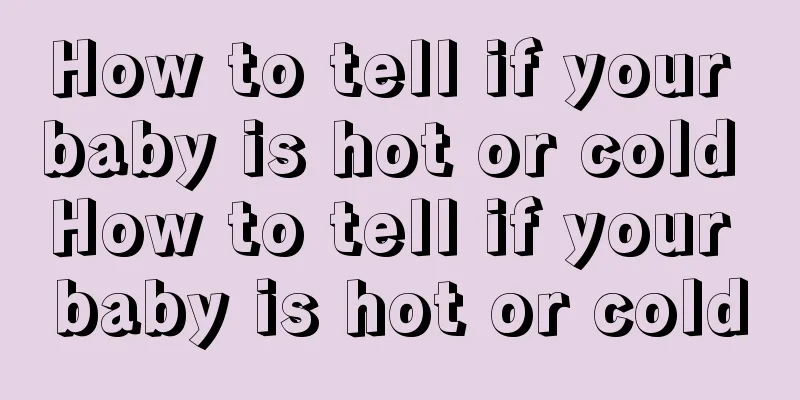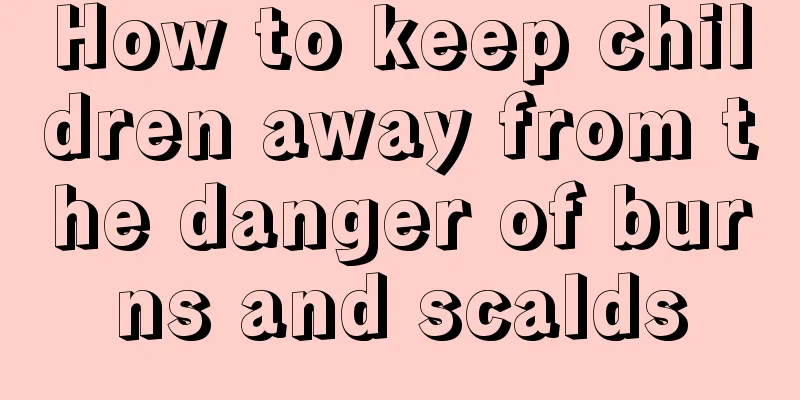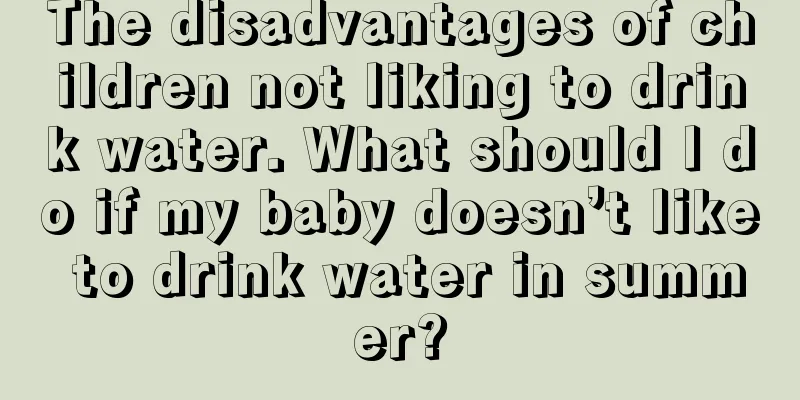How to tell if your baby is hot or cold How to tell if your baby is hot or cold

|
Many parents are new parents and have no parenting experience. They often dress their children too much, but they don't know that dressing too much is not good for their health. Parents should add clothes to their children according to the actual situation. So, how to judge whether the child is dressed too much? Today, let's teach you how to judge whether the baby is cold or hot. How to tell if your baby is cold or hotCold hands and feet does not mean the baby is cold Babies cannot accurately express their physical condition, so we often touch the palms and soles of their feet to judge whether they are hot or cold. When we feel that the baby's hands are cold or his feet are icy, we quickly put on a thick coat or quilt to keep him warm, but this often makes the baby sweat all over, or even cause heat syndrome. This is because young children have poor peripheral blood circulation. Sometimes their hands and feet are cold, but it is only because of air convection or low temperature that the peripheral temperature is low. In fact, as long as the central body temperature is within the normal range, it is fine. However, everyone's physique is different. Some babies' palm temperatures will gradually "warm up" as they grow older, while some babies' palm temperatures are always low. Parents should pay more attention to the baby's physiological changes and sense their "core temperature" by placing your palm flat on the baby's back or chest skin. Sweating does not mean the baby is hot Seeing the baby sweating profusely, we are eager to help him take off his coat, but unexpectedly a cold wind blows and the baby accidentally catches a cold... Even if the baby is sweating profusely, it does not mean that the baby feels too hot. The specific situation needs to be analyzed specifically and considered for reference. It is recommended that parents put their hands inside the baby's clothes and feel the temperature of the belly, back or neck. If the baby is sweating profusely, the body temperature feels high, and the body is also sweating, then it should be really hot! Sometimes, when babies are recovering from illness, they are prone to sweating on their heads. Also, babies have a fast metabolism, so they are prone to sweating a lot, such as when they have just cried or have been active for a short period of time. At this time, just wipe the sweat off and avoid being blown by the wind. In fact, in general, as long as you understand your baby's behavior patterns, you will be able to judge any behavioral changes in your baby and feel whether your baby is in good condition. First of all, the temperature changes felt by adults themselves are a reference point, but some fathers are very afraid of heat or mothers are very afraid of cold, so the reference point will be different. Furthermore, measuring the temperature change is a good way to understand the baby's current physical condition, such as touching the baby's back or chest with your own hand to feel whether the baby's temperature is normal, but everyone's body temperature is different, so this measurement method is still not very accurate. Even if you use electronic methods such as ear thermometers to measure body temperature, the data will be inaccurate and is for reference only. Finally, as parents, the most important thing is to observe the baby's spirit and activity status. If it is different from usual, special attention should be paid. Analysis of the parts of the baby that are afraid of coldPart that is most susceptible to cold: belly In traditional Chinese medicine, the belly is the place where the spleen and stomach are located. Keeping the belly warm is equivalent to protecting the spleen and stomach of the child. Children aged one or two often have a big belly, and their pants tend to slide down easily. When crawling, being held by parents, or playing games, the child's top may be lifted up to the chest and abdomen. A cold belly can easily damage the baby's spleen and stomach function, causing abdominal pain, diarrhea, indigestion and other diseases, so mothers should do a good job of keeping the baby's belly warm. Tips for keeping your belly warm Tip 1: Wear a bellyband. When it is cold, putting a bellyband on your baby for 24 hours is a good way to keep the baby's abdomen warm. If you are worried that your baby will kick off the quilt and get a cold belly when sleeping, you might as well put the baby in a sleeping bag, which will be much warmer. The second trick: thermal underwear. Thermal underwear is a must-have item for babies to keep warm in winter. Soft cotton underwear not only has good sweat absorption and breathability, but also allows air to remain around the skin, blocking the loss of body heat, making it less likely for babies to catch cold and get sick. At the same time, soft cotton underwear can not only absorb sweat, but also allow air to remain around the skin, blocking the loss of body temperature. What mothers need to pay attention to is that they should never choose synthetic fiber underwear for their babies just for the sake of easy washing, because the skin is in a state of astringency when it is cold, and the secretion of sweat glands is reduced. Synthetic fiber clothes will aggravate the dryness and discomfort of the baby's skin. Cold-sensitive area No. 2 Head and neck Traditional Chinese medicine believes that the head is where the three yang meridians of the hands and feet converge, so it is considered by traditional Chinese medicine to be the "meeting place of all yang" in the human body. When a baby is outdoors, the temperature of the head can be easily taken away by the cold wind, causing the baby to catch a cold and become sick. Therefore, when going out, you should always prepare a small hat for your baby to keep the head warm. Tips for keeping your head and neck warm Tip 1: Wear a hat when going out. Prepare a warm and comfortable hat for your baby to effectively protect the baby's head from getting cold. However, the hat should not be too thick in winter. If the head is overheated, it is easy to get upset and dizzy. The baby's head will get hot first when he is sick. Therefore, the hat should be soft, comfortable, of appropriate thickness, and breathable. The second trick: Wear a scarf. Wrapping a scarf around the baby's neck can prevent the baby's body temperature from escaping and can play a good role in keeping warm. The scarf is almost directly attached to the skin. The skin on the baby's neck is very sensitive and fragile, so when choosing a scarf for the baby, you must choose good quality wool, otherwise it is easy to irritate the skin allergies. Do not choose wool that is easy to shed. Scarves made of this kind of wool are easy for the baby to inhale the fluff into the trachea and lungs, causing respiratory diseases. Cold-sensitive part NO.3 Back Keeping the back "properly warm" can prevent diseases and reduce colds. "Properly warm" means not to keep it too warm, otherwise the back will sweat a lot, and when the sweat cools down, it is easy to get sick due to the dampness of the back. However, do not keep the back too warm. If the back sweats because of wearing too many clothes, it is easy to be affected by the wind and catch a cold. Therefore, mothers need to learn to dress according to the temperature of the baby's back. Tips for keeping your back warm Tip 1: Wear a vest. In winter, it is best to choose a wool sweater with good warmth retention, a cotton or down vest, and a cotton jacket or down coat on the outside. Wearing light and warm clothing will not restrict the child's movements. Once the body gets hot during physical activities, the cotton jacket can be taken off. The warmth retention of a sweater and a vest will not make the child cold. The second trick: use a sweat-absorbing towel. When it is cold, before your baby exercises, put a thin, absorbent towel on the baby's back. The sweat produced by the baby during exercise will be absorbed by the towel. After the exercise, take out the sweat-absorbing towel, and the baby's clothes will be dry and clean, so he will not catch a cold and get sick. Cold-sensitive part No. 4 Feet The feet are where the yin and yang meridians meet, and the skin is rich in nerve endings, making it the most sensitive part to the outside world. There is very little fat on the surface of the baby's feet, and the ability to keep warm is very poor. Keeping the baby's feet warm can better ensure that the body can adapt to changes in the external climate. Tips for keeping your feet warm Tip 1: Wear pure cotton socks. You should choose pure cotton socks with good breathability for your baby. Many parents also mistakenly believe that the thicker the baby's socks, the better the warmth. However, thick socks do not absorb sweat and are easily damp. A large amount of moisture will squeeze out the air in the sock fibers. Due to the lack of air, an excellent heat insulator, when the socks are damp, the soles of the baby's feet will become cold, which will reflexively cause the respiratory resistance to decrease and cause a cold. The second tip: suitable shoes. When choosing shoes, the size of the shoes should be suitable, and they can be slightly loose. The material should preferably be pure cotton, which is soft and comfortable to wear, and can store more still air in the shoes and have good warmth retention. Part that is most susceptible to cold: hands The baby's body temperature regulation center is imperfect and the ability to resist cold is poor. If the hands catch cold, it can easily lead to insufficient blood supply to the whole body, reflexively causing vasoconstriction of the nasal, pharyngeal, tracheal and other upper respiratory tract mucosa, reducing the resistance to pathogenic microorganisms. The pathogenic bacteria lurking in the body will take the opportunity to grow and multiply in large numbers, causing respiratory infections. Tips for keeping your hands warm The first step is to wear gloves. A pair of warm gloves can help your baby withstand the cold winter. When choosing gloves, you should try to wear cotton wool, woolen yarn or elastic nylon gloves. The size should be chosen according to the convenience of wearing and taking off, and the size should be appropriate. If the size is too large, the baby's finger joints will be inconvenient to move and will not have a warming effect; if it is too small, the blood circulation of the hands will be blocked. The second trick: rub the palms. Frequently rubbing the baby's hands (using moderate force on the palms and backs of the hands, rubbing repeatedly) can accelerate blood circulation and make the baby's hands warmer. Experts teach you how to judge Judging hotness or coldness by touching your hands and feet? Not reliable! Although the elderly have many years of experience in raising children, some of their practices lack scientific basis. So, who is the most authoritative person to judge whether a baby is hot or cold? Let's listen to the opinions of obstetricians from tertiary hospitals! Chen Jianfei, deputy head nurse of the obstetrics department of Guangdong Provincial Second People's Hospital, pointed out: "If the baby's hands, feet and face are cold, it does not necessarily mean that they are not warm enough." This is because the baby's blood flow is concentrated in the trunk and internal organs, and less in the limbs, which makes the hands and feet, especially the fingertips, far away from the heart, have poor blood circulation, which makes the hands and feet cold. At the same time, the baby's body temperature regulation center function is not yet fully developed, and the body cannot respond well to temperature changes. If you rush to add clothes to the baby, it may hurt the baby. If you touch your baby's neck and back and feel it is warm but his hands and feet are cold, you can put on gloves and/or socks for your baby to keep him warm and prevent him from catching cold or frostbite. Touching the back of the neck to know whether the child is cold or warm? It's reliable! How can you tell if your baby is wearing enough clothes? Chen Jianfei introduced a simple method: "To determine whether the baby is cold or warm, parents can just touch the back of the baby's neck. This is because the back of the neck is closer to the heart and can more accurately reflect the true body temperature." The specific method is: put your palm through the back of the child's collar and touch the back of the baby's neck and vest. If the skin feels warm and dry, it means the clothes are suitable; if it is damp and sweaty, it means that the baby is wearing too much and should wear less clothes; if it feels cold, add clothes in time. When testing, pay attention to the fact that the adult's palm should be warm and dry to avoid irritation to the baby. In view of the fact that babies have a fast metabolism and relatively high body temperature, Chen Jianfei has summarized a set of simple dressing rules for parents to refer to: babies under 1 year old can wear one more piece of clothing (of average thickness) than adults; babies between 1 and 2 years old can wear the same amount of clothing as adults; children over 3 years old can basically express the feeling of cold or heat, so they can be dressed according to their feelings and wishes. Does sneezing mean you have a cold? Not necessarily! Many times, parents get nervous when they hear their baby sneeze, thinking that the baby has caught a cold, and quickly put on more clothes. "In fact, it is normal for babies a few months old to sneeze, and it does not necessarily mean that they have caught a cold," said Chen Jianfei. Before a newborn baby is born, the amniotic fluid environment of the mother is clean and pure. After birth, the temperature difference between the inside and outside of the body and the lack of nasal hair to block the fine particles from the outside will irritate the baby's nose, resulting in sneezing. If sneezing is accompanied by a runny nose, it may be a cold. Many parents will boil scallion water, brown sugar and ginger water for their babies to drink to treat colds, but this practice is not entirely correct. Chen Jianfei recommends that babies under 6 months old should not use this method to avoid irritating the delicate stomach. After 6 months, complementary foods are added and the baby can drink appropriately. In addition, this method is only effective for colds caused by colds at the beginning. Colds are self-limiting diseases and can heal themselves even without medication. As long as you pay attention to rest and drink plenty of water, you can shorten the course of the disease. If the symptoms continue to worsen or high fever occurs, you need to see a doctor in time to confirm whether there are other causes. |
<<: What causes abdominal pain during ovulation in women? How to relieve it?
>>: Before giving birth, women should evaluate whether they have any troubles during pregnancy.
Recommend
What are the taboos for women before pregnancy
Newly married couples who have just finished thei...
How to treat eczema in children in winter and what to eat
Eczema is a common skin condition in young childr...
The main purpose of the umbilical cord patch Why do babies need to use the umbilical cord patch
Umbilical cord stickers are a product that we are...
What are the benefits of wearing silver bracelets for babies? At what age can babies wear silver bracelets?
In recent years, many parents like to give their ...
What material is the best for baby bottles?
Parents usually worry about their baby's heal...
What are the symptoms of intellectual disability in premature babies? Will premature babies have intellectual disability?
What are the symptoms of intellectual disability ...
How to deal with baby rash? Teach you how to deal with baby rash easily
Many parents will be very worried when their baby...
At what age should children start reading? What kind of books are good for children?
My friend's child is over three years old, bu...
Can babies with diarrhea take probiotics? What are the benefits of probiotics?
It is a normal phenomenon for babies to have diar...
Which brand of baby shampoo is good? Three major shampoos recommended
The ingredients and formulas of baby shampoos and...
How long does it take for pregnant women to cook beef rolls? Can pregnant women eat beef rolls bought in supermarkets?
Beef rolls are everyone’s favorite food when cook...
How to increase nutrition for children who are too thin? What can children who are too thin eat to gain weight?
Usually most children are thin, because many chil...
Does the crib contain formaldehyde? What should I do if the crib smells?
Cribs are products that many babies need. Usually...
What are the symptoms of pregnancy reaction? What are the symptoms of pregnancy reaction?
Usually in the early stages of pregnancy, mothers...
Can cheese and yogurt provide calcium for babies? How to choose dairy products to supplement calcium for babies?
The nutritional problem of babies concerns parent...









